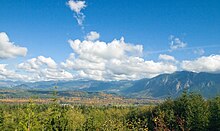
King County is a county located in the U.S. state of Washington. The population was 2,269,675 in the 2020 census, making it the most populous county in Washington, and the 12th-most populous in the United States. The county seat is Seattle, also the state's most populous city.
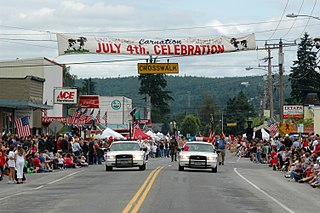
Carnation is a city in King County, Washington, United States. It was historically known as Tolt and lies at the confluence of the Snoqualmie and Tolt rivers.

Duvall is a city in King County, Washington, United States, located on SR 203 halfway between Monroe and Carnation. The population was 8,034 at the 2020 census.

Fall City is an unincorporated community and census-designated place (CDP) in King County, Washington, United States, 25 miles (40 km) east of Seattle. The community lies along the Snoqualmie River and Raging River. The population was 2,032 as of the 2020 census.

North Bend is a city in King County, Washington, United States, on the outskirts of the Seattle metropolitan area. The population was 7,461 at the 2020 census.

Snoqualmie is a city next to Snoqualmie Falls in King County, Washington, United States. It is 28 miles (45 km) east of Seattle. Snoqualmie city is home to the Northwest Railway Museum. The population was 14,121 at the 2020 census.

Monroe is a city in Snohomish County, Washington, United States. It is located at the confluence of the Skykomish, Snohomish, and Snoqualmie rivers near the Cascade foothills, about 30 miles (48 km) northeast of Seattle. Monroe's population was 19,699 as of the 2020 census.

The Snoqualmie River is a 45-mile (72 km) long river in King County and Snohomish County in the U.S. state of Washington. The river's three main tributaries are the North, Middle, and South Forks, which drain the west side of the Cascade Mountains near the town of North Bend and join near the town of Snoqualmie just above the Snoqualmie Falls. After the falls the river flows north through rich farmland and the towns of Fall City, Carnation, and Duvall before meeting the Skykomish River to form the Snohomish River near Monroe. The Snohomish River empties into Puget Sound at Everett. Other tributaries of the Snoqualmie River include the Taylor River and the Pratt River, both of which enter the Middle Fork, the Tolt River, which joins at Carnation, and the Raging River at Fall City.
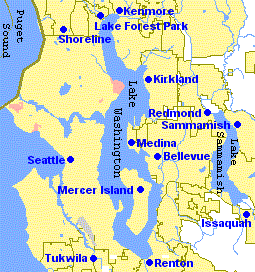
The Eastside of the King County, Washington area in the United States is a collective term for the suburbs of Seattle located on the east side of Lake Washington.

Stevens Pass is a mountain pass through the Cascade Mountains located at the border of King County and Chelan County in Washington, United States. U.S. Route 2 travels over the pass, reaching a maximum elevation of 4,061 feet (1,238 m). The Pacific Crest Trail crosses the highway at Stevens Pass. The BNSF Railway's Cascade Tunnel lies 1,180 feet (400 m) below the pass summit.

The Skykomish River is a 29-mile (47 km) long river in the U.S. state of Washington which drains the west side of the Cascade Mountains in the southeast section of Snohomish County and the northeast corner of King County. The river starts with the confluence of the North Fork Skykomish River and South Fork Skykomish River approximately one mile west of Index, then flowing northwesterly towards Puget Sound. It is joined by the Sultan River and the Wallace River at Sultan. It then meets the Snoqualmie River to form the Snohomish River at Monroe. The Snohomish River continues along the river valley eventually dumping into Port Gardner Bay on Possession Sound.

State Route 203 (SR 203) is a state highway in the U.S. state of Washington that traverses part of King and Snohomish counties. It runs north–south for 24 miles (39 km) through the Snoqualmie Valley, connecting Fall City, Carnation, Duvall, and Monroe. The highway terminates to the south at a roundabout with SR 202 near Fall City and to the north at a junction with U.S. Route 2 (US 2) in Monroe.

The Snoqualmie Valley Regional Trail is a rail trail in King County, Washington. The 29-mile (47 km) trail follows a portion of the former alignment of the Milwaukee Road, which was constructed in 1911 and abandoned in 1973.

The Raging River is a tributary of the Snoqualmie River in western Washington state in the United States. It is located in the western foothills of the Cascade Mountains in east central King County, Washington. It gets its name from the large amount of water it sometimes carries. The record discharge at the gaging station is over 4,000 cubic feet (110 m3) per second. The Raging is a salmon-bearing river and supports one-fifth of the Snoqualmie River's chinook runs.
The Skykomish Valley, nicknamed Sky Valley, is a region of Snohomish County, Washington, United States, that lies along the Skykomish River. It stretches from Snohomish to the Cascade Mountains, terminating near Skykomish, Washington. The towns from east to west include Skykomish, Baring, Grotto, Index, Gold Bar, Startup, Sultan and Monroe.
Deer Falls is the uppermost waterfall on the North Fork Skykomish River. The falls occur within a short but impressive canyon just above the mouth of Goblin Creek.
The Foss River is a stream in the U.S. state of Washington. It has two main forks, the East Fork Foss River and the West Fork Foss River. The main stem is formed by the confluence of the two forks. The river and its forks rise near in the Alpine Lakes Wilderness area of Mount Baker-Snoqualmie National Forest in the Cascade Mountains and flows generally north, joining the Tye River to form the South Fork Skykomish River. The Foss River's waters eventually empty into Puget Sound near Everett via the Skykomish River and Snohomish River.
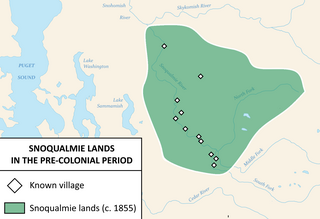
The Snoqualmie people are a Lushootseed-speaking Southern Coast Salish people indigenous to the Snoqualmie Valley, located in east King and Snohomish counties in the state of Washington.
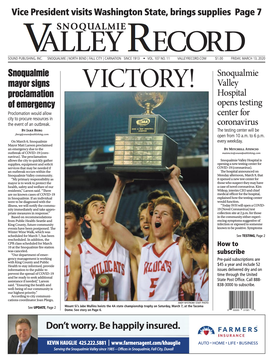
The Snoqualmie Valley Record is a weekly newspaper in King County, Washington, United States. The paper was founded as the North Bend Post in 1913 and has published continuously since 1923 as the Snoqualmie Valley Record. The paper covers news in the Snoqualmie Valley, which includes North Bend, Snoqualmie, Preston, Fall City, Carnation, and Duvall.
C. Louise Miller is an American politician and educator from Washington. Miller is a former member of the King County Council, third district, which includes North Bend, Snoqualmie, Issaquah, Sammamish, Fall City, Preston, Duvall, Redmond, Carnation, Skykomish, and part of Woodinville. Miller is a former Republican member of Washington House of Representatives.
